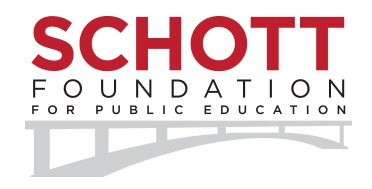Philos Issue 6
Organizing Communities and Organizing Funders: Unlocking the Potential of Philanthropy in the South
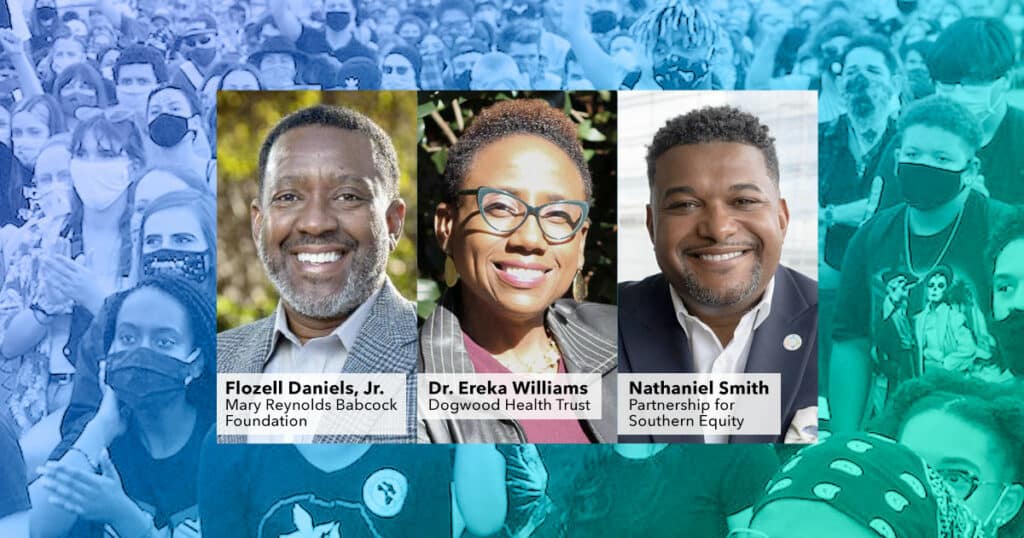
The need for education funders to invest in racial equity and justice has been ever more urgent for the past decade, and over the last few years, the need to fund that work in the South has been proven repeatedly.
Given the present moment, how best can funders expand or begin to support efforts in southern states? What’s unique about the social, political, and educational landscapes that will affect the work? Is this a “use it or lose it” moment for funders?
We brought together three expert leaders to explore these questions: two funders and an advocate. Flozell Daniels, Jr. is the CEO of the Mary Reynolds Babcock Foundation, which operates and funds across the South. Dr. Ereka Williams is Vice President of Education for Dogwood Health Trust, a North Carolina funder that focuses on eighteen counties and the Qualla Boundary in the west of the state. Nathaniel Smith is the founder and Chief Equity Officer of the Atlanta-based Partnership for Southern Equity, which advocates for racial equity and shared prosperity in metropolitan Atlanta and the American South.
Schott: Southern states are educating almost half of all K-12 students and a majority of K-12 students of color. And yet, education philanthropy dedicates less than a quarter of its racial equity and justice grants to the region — a region that also has longstanding difficulties with equitable public funding of K-12 education. What do you think are the reasons for this mismatch?
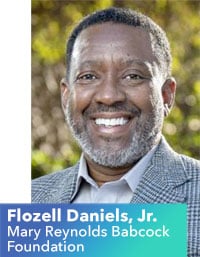 Flozell Daniels: This country is in one of the most interesting and dangerous pivot points in recent history, where elected leaders are pushing back on the very idea of public goods. Particularly in the South there are very powerful, very wealthy, people who are against public education as a public good and at the scale necessary to meet our societal needs.
Flozell Daniels: This country is in one of the most interesting and dangerous pivot points in recent history, where elected leaders are pushing back on the very idea of public goods. Particularly in the South there are very powerful, very wealthy, people who are against public education as a public good and at the scale necessary to meet our societal needs.
And while all of these things are happening, folks are struggling economically and under attack from a democracy perspective. It’s increasingly more difficult for them to access the franchise and to vote in people who actually represent them, their families and their communities.
The Mary Reynolds Babcock foundation is in its 70th year of social justice philanthropy. And we have the privilege of working across eleven southern states, from Louisiana to Virginia.
I live in New Orleans. I’m a product of public schools. I was the child of a teenager. And high quality teaching elevated me in my life trajectory. For 13 years, educators cared deeply about me and knew what to do to help me succeed academically and in life. They were a partner to my mom, and my family. They had the resources they needed to be effective. They had textbooks that were reflective of best practices and what was needed to be successful. And students had support staff, counselors, coaches, other people who were making sure that we were engaged in leadership development work.
What we’re seeing now is that’s not necessarily what the schools can offer. And there is a direct thread between those practices and the policy and the funding decisions made at the top of the food chain.
That goes to the heart of why philanthropy is not just lagging, but is missing an opportunity to fulfill its duty to support the parents, communities, and organizations working for transformational educational opportunities for people throughout the South.
I don’t want to miss a very important population in the funder world, and that is individual donors who are active in local and regional spaces. And what I have experienced with many is that the donor will come and say, “I know something better than you do, about how to educate you or your children, trust me.” And typically, that argument is populated with a misunderstanding of the historical context and dynamic.
So in New Orleans, for instance, they said, “it was a disaster before, so we’re just going to wipe the slate clean and start anew.” And they were in fact wiping away the positive, affirming, and effective experiences of tens of thousands of people by saying it was a disaster.
And I’m standing right here, with hundreds of alums of my one school, who are successful, who are good citizens, who contribute to society. But it has felt to me like racialization. It’s a school population with mostly Black teachers, Black leaders, and Black children. And if it’s not performing to a certain standard, some funders think it must be because they don’t know what to do. They never consider it’s because the schools are historically — and continue to be — under resourced.
And so to me, that’s a big problem with funders and donors who say they care about public education, but who come in not as partners who trust and believe in people: they parachute in believing they know better, with no evidence or experience or capabilities to know better or to do better.
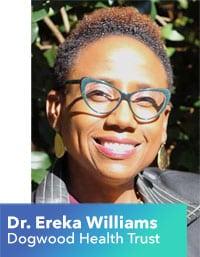 Ereka Williams: Dogwood Health Trust is a four-year-old foundation. The beautiful thing about starting a portfolio at a brand new philanthropic organization that doesn’t have a 100 or 200 year history is that you can build the narrative for this philanthropic organization and specifically my portfolio, which is education from the ground floor.
Ereka Williams: Dogwood Health Trust is a four-year-old foundation. The beautiful thing about starting a portfolio at a brand new philanthropic organization that doesn’t have a 100 or 200 year history is that you can build the narrative for this philanthropic organization and specifically my portfolio, which is education from the ground floor.
I’m a licensed public school teacher and a product of public schools and universities in the state of North Carolina or the South. I started as a teacher in rural southeastern North Carolina at 21, I’ve had a nearly thirty-year career in the field, and remain close to the state of schools here, across the region, and across our country quite simply, it’s been my life.
I often reflect on how we are approximately 70 years since Thurgood Marshall led the legal efforts that culminated in the 1954 Brown v. Board of Education Supreme Court decision. I think about the promises that were made: that the public good of education was for everyone regardless of zip code, regardless of race, regardless of where your parents were born. As we enter 2024, we sit here now looking at resegregated public school communities. We’re looking at academic access, performance and conditions for students of color that are in some ways far more dismal than they were a generation ago. This current state of affairs, prompts difficult but necessary questions for the sector. What have we been doing? How have we deployed our various forms of capital? Where have the resources made an impact? How have our portfolios in philanthropy served — and more importantly, not served — the clear needs of our children?
I would encourage those of us in philanthropy to remember that while we may be showing up now, and those who are should be commended for that, before our arrival in these spaces, there have been people in these communities — grassroots activists, community-anchored organizations, engaged citizens, and community leaders — leading in and making change for years for decades.
As philanthropy shows up in these spaces, it’s essential to remember the adage: Seek first to understand, not to be understood. Show up and listen, be still, and in community with the people who have been doing this work when few or no one else was paying attention, those who have been going to the community and board meetings, writing the op-eds in local papers/blogs, serving as community or cultural brokers for those who needed real time advocates, showing commitment to and advocating for families and children who might otherwise have no voice.
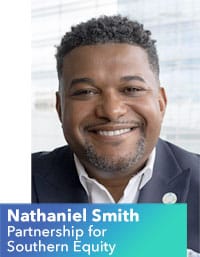 Nathaniel Smith: The founding of the Partnership for Southern Equity stems from my own experiences as a child of Southern Freedom Movement activists and growing up in a time where the landscape was shifting as to what was needed to advance a more inclusive society.
Nathaniel Smith: The founding of the Partnership for Southern Equity stems from my own experiences as a child of Southern Freedom Movement activists and growing up in a time where the landscape was shifting as to what was needed to advance a more inclusive society.
As we honor our past leaders and organizations, we all — not just PSE, but all organizations —need to bring something that adds value to the marathon of liberation we’re all running at this moment and helps us win.
Unfortunately, among philanthropies aligned with our values, I don’t think many of them actually fund to win. They fund to facilitate the realization of their goals and objectives, sure. But, in terms of dollar amounts, that is a different number of zeros than funding an organization to win.
Those funders who do want to keep the status quo, or even regress, know better. They understand that they must fund organizations to win. And that funding has to last for many, many years, not just a grant cycle.
There are some foundations who seem to believe we can undo structural racism in a grant cycle. That is unrealistic. And I think that, to me, that lack of perspective holds back potential successes in the movement.
There is a deeply rooted cultural belief that the value of Black folks and other historically disinvested communities of color can be found primarily in labor and consumption, but not as creators and assets to society. For philanthropy, we have to fight this cultural assumption that Black folks and children of color are a liability first, before they are an asset, and move away from a missionary mentality. Funders need to look at Black children and other children of color as the future of the society that we’re fighting for.
So that has been a lot of the focus: how can we shift the burden away from the applicant or the grantee on to ourselves?
Nahir Torres, Hyams Foundation
The past decade, especially the past few years, has shown the increasingly urgent need for funders to invest in racial justice in the South. Given the demands of the present moment, how best can funders expand or begin to support racial justice organizing efforts in southern states?
Flozell Daniels: I think you have to come into communities and do your discovery work, be able to talk to people on the ground to actively look for funding formations. In New Orleans, for example, we have the Greater New Orleans Funders Network.
If you want to fund in a certain area, you have to actively look for those spaces where folks are showing up, like at school board meetings. Are there any formations and groups that are showing up consistently with an analysis and recommendations? You can also find and reach out to philanthropic colleagues who are funding education in that place to see what they’re learning.
If you’re a funder with an equity agenda and you don’t fund a long-term advocacy strategy, you’re not going to be successful. I’ve never seen it work. Funders must find the local and regional groups doing the racial equity work, the grassroots work, that are working on policy and advocacy, and have some sophistication. It’s also important to recognize the power and ability of nascent, small groups to move the resources you can offer, either directly or through intermediaries.
And the last thing I would ask funders: consider making a generational commitment. We know that as a practical matter that can be difficult. A generational commitment, which for us means at least ten years of funding, is crucial because people need support for enough time to be able to get their legs under them, get a rhythm for the work and consistently show up for the communities they serve.
Ereka Williams: I would first encourage those groups to really do a deep self-assessment. Since 2020, we saw a lot of different sectors, not just philanthropy, make a lot of statements about racial equity and justice. Here in 2023, we have found that many of those statements and promises were hollow. A lot of decisions that were made and appeared to be in the interest of equity and advancement have been rolled back or watered down.
In light of this cautionary tale, any sector, including philanthropy, that believes they’re ready to get really serious about this work in a different way needs to do an honest self-assessment of where their portfolio has been and make sure there’s no ambivalence, awkwardness, or confusion around where they intend to go. They should think about their existing strategy, past and present, so that they can make the best use of their capacity in service of what they believe they want to do. Then it’s a matter of building relationships to make sure you’re actually helping contribute to the cause. I think sometimes our intentions are good, but we get ahead of ourselves before we’ve done the kind of internal housekeeping that needs to be done. I would encourage that to be the first order of business.
We’ve had partners at the table with us, digging into thorny questions. Does this strategy address some core issues now? Does it address the systemic structural issues that have been getting in the way of progress here? We’re looking at the long game: we’re taking a seventh-generation approach, the indigenous perspective that reminds or tells us that the seeds that we plant today will not be harvested in our lifetimes. What is it that we can do systemic and structurally, in lockstep with the community here? When this seed is harvested generations down the road, will it serve to disrupt these systemic structural issues? Will it change the narrative and outcomes for our communities in our footprint?
Nathaniel Smith: I think it’s important for anyone who’s going to invest in a particular place to take the time to understand the history of their place. Funders can use a cookie cutter approach as it relates to how they invest in organizations, and that can lead to disastrous outcomes. Getting it right might even involve funders hiring an anthropologist, or a qualitative researcher, who can help them inform their philanthropy. But it always starts with being in conversation with communities.
Funders need to critically examine their own practices and history. Are they perpetuating inequity through their funding strategies? The data shows big differences in funding levels between white-led and BIPOC-led organizations. Are they actually investing in organizations that are on the front lines, led and governed by people who look like the people they want to serve and support?
Funders must believe deeply that the people closest to the problems are closest to the solutions. The philanthropic sector has created this consulting class through which they spend so much of their resources to have people come in and tell people on the front lines what they already know. Instead, what are the opportunities for funders to truly learn from the genius of the people in community? Funders need to see the communities they operate in as co-creators of the world they want to see, not as people who need to be saved from themselves.
There are some foundations who seem to believe we can undo structural racism in a grant cycle. That is unrealistic. And I think that, to me, that lack of perspective holds back potential successes in the movement.
Nathaniel Smith, Partnership for Southern Equity
Suppose a foundation has an existing portfolio in the Northeast or Midwest and wants to expand to include grantees in southern states. What considerations and potential challenges should the funder keep at front of mind when doing so? How can funders introduce themselves to partners in the south in ways that build community and mutual trust?
Flozell Daniels: I remind funders all the time, and I have to remind myself frequently, that we have the most flexible opportunities of any sector. I have a wonderful board, I’ve got a dynamic staff, I have an endowment. We have resources every year allocated in the budget. And so we get to move money, within the confines of the law, in any way that makes sense to us.
As someone who was once a grant-seeker running an intermediary, I would tell funders all the time: I am very much able to absorb large grants from you. Don’t look at my balance sheet and think that’s an indicator of my capacity to absorb additional dollars. Almost everybody starts small.
I’ve been a philanthropy CEO for 16 years now, and I can’t tell you how many times I’ve had staff say to me, “I’ve got this great idea,” and they share it with me, and then they’d follow it with, “but the board will never go for it.” There can be a fear among staff that keeps the best ideas from moving past the drawing board, and foundation leadership should create cultures that encourage everyone to step out a bit. We should be fearless the way our grantees and partners in the field are fearless. We owe it to them.
What I think great grantmakers do is to organize inside the way we expect people to organize outside. Your board and your committee are your constituents: organize them! You’ve got to be able to bring them along — in some cases, drag them along — so they can see what you see, through things like site visits and grantee presentations.
For us, board education and organizing allowed us to transform how we’re funding social justice work in Tennessee. We brought in grassroots groups to present to our board about their capacity, leadership development, strategy, and long-term horizons, and board members were astonished by two things: their sophisticated approach and how few people were funding their work. As a result of this process, we have completely shifted our ability to imagine our funding strategy in Tennessee. If we hadn’t put in that effort up front, that would have been much less likely.
Ereka Williams: Listen and lean into the groups that have been doing the work. I would encourage new funders to lean into some of the Southern philanthropic groups that have been very explicit about being direct and bold in naming equity or specifically racial equity as a part of their agenda and putting real dollars into that commitment. Folks like Mary Reynolds Babcock Foundation, Z. Smith Reynolds, and other organizations that have had dedicated strategic directions around the South and around racial equity.
Look at the grassroots organizations rooted in the South and have been trying to move the needle and support their work. The Center for Racial Equity in Education, CREED, comes to mind, under the leadership of Dr. James Ford. He was a teacher for many years and was the first Black male state teacher of the year in North Carolina. He later served on the state board of education, and then decided he needed to intervene in public education differently by founding CREED. He and his team have been doing important work that up until recently was largely unseen by funders.
Lifting your grantee partners to your fellow funders is a crucial part of moving the needle. It’s like the African proverb: we can go fast and go alone, or we can go far and go together. Philanthropy must show up for these kids and communities at the margins, all of them.
Nathaniel Smith: Funders need to get on a plane, come down to neighborhoods and see what is happening on the ground. That’s the starting point to build real trust. It may not be an overly formalized site visit — just come and see what’s happening in the community so you can understand what’s going on.
I think funders who care about the community will think about the end before they think about the beginning. They first aim to ensure that something meaningful is left behind that will allow these organizations to continue to fight and be successful. That could be increased capacity, or a strategic plan, or some more solid organizational structures, or a line item in a local government’s budget, or generational assets like an endowment or property in real estate.
If you trust the organization, then give them the money they need, give it for multiple years, and let them innovate as they best know how. The funders that I have the best relationships with are the ones willing to own their limitations and know that for them to win, I have to win, and vice versa. It’s a complementary relationship.
When you’re talking about work in the South, I think that it must be a commitment from foundations to spend more than 5% a year on the work that is needed to turn the South around. We need people to fund organizations in a way that shows that they believe in their heart that these groups can win. If we can do that, then I think real change can happen.
A generational commitment, which for us means at least ten years of funding, is crucial because people need support for enough time to be able to get their legs under them, get a rhythm for the work and consistently show up for the communities they serve.
Flozell Daniels, Mary Reynolds Babcock Foundation
Any discussion of the similarities that knit together southern states runs the risk of homogenizing the region. New Orleans is not Asheville, which is not Jackson, which is not Miami. How should grantmakers balance 1) the importance of building and funding solidarity and collaboration across the region and 2) tailoring grants to the needs and priorities of a particular state and community?
Flozell Daniels: We’re not a categorical funder as much as we are a thematic funder: we’re looking to resource leaders and organizations across the South who are building power toward racial equity outcomes. And that looks different from one state to the next.
We work across 11 states. You’ll notice we use the term “network officer” rather than “program officer” in our team because for us, what we’re trying to do is fund formations. The strategy in Louisiana is going to look different than the strategy in Georgia, or Alabama, or Virginia. Each has different groups, different priorities, different levels of capacity, and people are at different places on their trajectory. This gives us a chance to meet people where they are, and they can meet us where we are in our own learning journey in understanding how support them.
We make the argument that although we’re in the South, these southern leaders and organizations are modeling behavior in work and practice that is nationally relevant. These organizations have lessons and stories to tell that can be picked up and used elsewhere.
Southern communities have always been innovative and thoughtful, and by necessity they’ve been creative in a low-resource environment to get extraordinary things done. Look at how much of the education civil rights work came out of the South, led by folks who didn’t have any resources. And even now, some of the best education advocacy, organizing, and policy work is coming out of southern leaders who are really stepping into the gap despite lacking the funding and support they deserve.
Our commitment to those doing the work on the ground leads us not just on our own journey of learning but compels us to educate and advocate among our fellow funders to build a lasting shift in our sector.
Ereka Williams: Questions of place hit home for me on a personal level. I grew up in rural eastern North Carolina, in one of the 10 poorest counties (of 100), among a predominantly African American set of counties in the state. Now, thirty years later, I’m living in the western part of the state among the 18 counties of the rural west.
We have common issues across all of North Carolina: public education funding, transportation, access to high-quality healthcare, and jobs with living wages. The issues out here in the west of the state mirror the issues in the east, however, they have some different nuances to them, which doesn’t allow one to paint all of North Carolina with one brushstroke. So, a funder interested in this state will find themes that resonate from the coast to the mountains of North Carolina for sure. However, their grantmaking approach or offerings may need tweaking from one region of the state to the other and that’s an intra-state nuance alone. Imagine or multiply that intra-state nuance by all our southern states, their diversity and it’s easy to see how the monolithic ‘South’ can quickly disappear.
Sure, there are common threads that connect and bind Southerners together even when on the surface we appear or look different. I think part of our role (philanthropy) as conveners in this space is to facilitate the dialogue and connections needed with folks at the margins so that they can build coalitions, unite, and address these issues with public and private support. The advocacy policy muscle needed to shift narratives and outcomes will require strength in numbers and collaboration.
Sometimes people are so busy trying to survive that they don’t have the opportunity to look at how their experience connects to other lived experiences and other parts of the South. And that’s true even when they’re in the same state. We have a lot of different roles we can play in philanthropy to help address that. It’s up to us to decide how we sit with them and understand what’s going on. It’s not a one-size-fits-all approach.
Nathaniel Smith: The first thing funders need to keep in mind is that empathy is the bridge between love and action. In order for you to really be embraced by community, you have to grow your empathy muscle and avoid the sympathy muscle, which is rooted in a missionary paradigm.
We try our best to knit together diverse communities from all across the South. We just held our first Southern Unity for Racial Justice & Equity (SURJE) Summit, in Memphis, that brought more than 400 people together and showed the power of collaboration and relationship-building.
A wise man once said, “Anything below the Canadian border is the South.” The history of oppression, of structural racism, what I call the neo-confederacy, affects people in Idaho too, not just places like Atlanta, Georgia. We’re not fighting against a person, or even an organization or policy, but against a value system and a worldview that continues to separate us and harm us.
We all know that funders, and in particular funders and family foundations in the South, have the money they do because their predecessors and benefactors did some horrible, horrible things. It’s important to create spaces for that kind of real conversation to happen. Most people and organizations have real respect for foundations that are willing to do the internal work of showing up in a different way. As part of that, I think a foundation must own where and how they got their money.
And then write the check. Don’t come into a community and ask them to jump through a dozen hoops just for a $50,000 check. That’s the most tangible difference between the foundations that get it and those that don’t.
